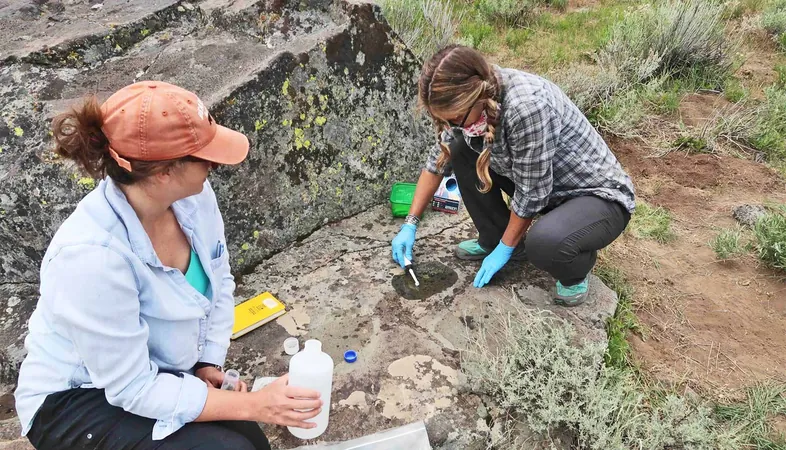
Unveiling Ancient Culinary Secrets: The Fascinating Findings from Stone Cooking Tools
2025-04-07
Author: Wei
Introduction
Recent research is revealing how ancient stone kitchens hold secrets about the diets and lifestyles of early human societies. Archaeologists have long known that our modern kitchen tools—such as mortars, pestles, and cutting boards—are descendants of ancient implements, specifically manos and metates, found at archaeological sites worldwide.
The Significance of Manos and Metates
A mano is a handheld stone tool that works in conjunction with a metate, a larger stone used for grinding and pulverizing diverse food sources. Some of these metates date back an astonishing 15,500 years, showcasing the deep roots of human food preparation practices.
Advanced Research Techniques
Researchers at the Natural History Museum of Utah have developed advanced techniques to extract microscopic plant residues nestled in the crevices of these metates, aiming to uncover vital information about ancient diets. Their groundbreaking study is published in the prestigious journal American Antiquity.
Insights from the Research
Stefania Wilks, an archaeobotanist at the Natural History Museum of Utah, highlights the rich history of food processing in the Western United States, where people have been using ground stone tools for millennia. Wilks' research delves into the types of plants used for nourishment and medicinal purposes, shedding light on traditional lifestyles and environmental changes over time.
Focus on Starch Granules
Working alongside NHMU's Curator of Archaeology, Lisbeth Louderback, Wilks is focused on recovering starch granules—tiny structures within a plant used to store carbohydrates—from various metates across western North America. These granules are minuscule, often smaller than a tenth of a millimeter, making them invisible to the naked eye and requiring specialized extraction techniques to locate them.
The Role of Bedrock Metates
Louderback initially suspected that the bedrock metates, despite being exposed to the elements, could conceal hidden starch granules because of the tiny crevices in the stone. "By grinding and mashing, ancient peoples could have forced these starches into the rock," Wilks explains.
Variability in Metate Appearance
The appearance of bedrock metates can vary significantly, shaped partly by the type of stone used. For instance, in Utah, they often appear as elongated grooves carved into sandstone, whereas other regions might feature circular or deep, round shapes resembling contemporary mortars. Though perhaps not as visually striking as arrowheads, these stone tools are rich in historical significance, documenting the plants processed by ancient communities.
Cultural Connections and Evidence
In areas with significant basalt outcrops, such as southern Oregon, numerous bedrock metates align with an abundance of petroglyphs and culturally significant plants, particularly geophytes—plants with starchy roots and tubers. This previously unexamined evidence indicates that these high uplands were used not only for hunting but also as places for plant processing.
Sample Collection and Analysis
To evaluate the use of bedrock metates for food preparation, Wilks and her team collected samples from the surfaces and their crevices. They utilized an electric toothbrush and a deflocculant (similar to laundry detergent) to separate and analyze the buried residues. The deep extracts revealed a treasure trove of starch granules, which were absent from the surface layers.
Identifying Plant Species
The researchers meticulously identified the plant species contributing to these granules, narrowing down many to specific families, including members of the carrot family and wild rye, which hold ongoing importance as food sources for local Indigenous peoples.
Importance of Starch Analysis
Wilks emphasized that starch analysis is crucial for understanding ancient human diets, especially since many food plants, particularly root vegetables, do not preserve well in archaeological contexts. This innovative method of extracting starch granules from overlooked bedrock metates is transforming the way researchers study the dietary habits of early humans, offering fresh insights into their daily lives and reliance on the natural world.
Conclusion
As we uncover these culinary secrets of the past, we gain a deeper appreciation for the resilience and adaptability of humanity, drawing connections between our ancestors and present-day food practices. What other ancient mysteries lie hidden within the stones? The journey of discovery continues!





 Brasil (PT)
Brasil (PT)
 Canada (EN)
Canada (EN)
 Chile (ES)
Chile (ES)
 Česko (CS)
Česko (CS)
 대한민국 (KO)
대한민국 (KO)
 España (ES)
España (ES)
 France (FR)
France (FR)
 Hong Kong (EN)
Hong Kong (EN)
 Italia (IT)
Italia (IT)
 日本 (JA)
日本 (JA)
 Magyarország (HU)
Magyarország (HU)
 Norge (NO)
Norge (NO)
 Polska (PL)
Polska (PL)
 Schweiz (DE)
Schweiz (DE)
 Singapore (EN)
Singapore (EN)
 Sverige (SV)
Sverige (SV)
 Suomi (FI)
Suomi (FI)
 Türkiye (TR)
Türkiye (TR)
 الإمارات العربية المتحدة (AR)
الإمارات العربية المتحدة (AR)